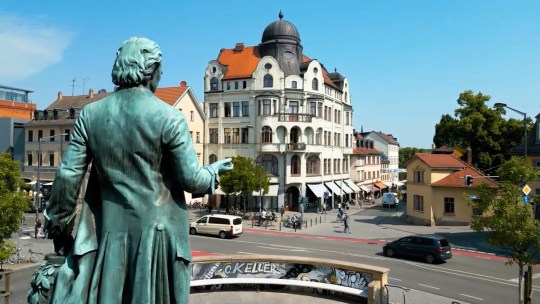#Buchenwald
Explore tagged Tumblr posts
Text

Buchenwald concentration camp, April 1945 - by Margaret Bourke-White (1904 - 1971), American
344 notes
·
View notes
Text

TODAY'S FROZEN MOMENT - 80th Anniversary April 11th, 1945 - Four-year-old Joseph Schleifstein, on the day of the liberation of Buchenwald, having survived by being hidden by his father initially in a sack, and with the help of fellow prisoners, well fed and protected - literally the embodiment of hope - Two years from this day, in 1947, Joseph and the remainder of his family emigrated to America, where Joseph grew up, married and had children, to whom he never told one word of his experience... Then in 1999, when his story and photos were discovered by a historian, he was tracked down, and he finally opened up with an interview for a newspaper... now called "The Life Is Beautiful Child" (referring to the movie made about this)... And although he did have recurring nightmares and painful memories, he harbors no bitterness... "I think that hate destroys the hater," he said. Moving past bad things, evolving out of them, while never forgetting or forgiving evil, is the path of hope and light....
[Mary Elaine LeBey]
#WWII#Buchenwald#concentration camp#Joseph Schleifstein#Life is Beautiful#history#1945#Mary Elaine LeBey
26 notes
·
View notes
Text
Buchenwald Concentration Camp Crematorium. Since I have gotten DM's saying "holohoax" before, this is a fuck you to Holocaust deniers.

#wwii era#ww2 history#wwii#ww2#ww2 germany#wwii germany#3rd reich#reichblr#buchenwald#Buchenwald concentration camp
23 notes
·
View notes
Text
this opinion might make me that one friend who is too woke, but i think we as germans we should retire this phrase and replace it with something like "jeder wie er will"

translation:
person a: "it's not really my cup of tea, but-"
person b: "to each their own"/"to each what they deserve"
4 notes
·
View notes
Text
Ilse Koch, "the witch of buchenwald"

9 notes
·
View notes
Text



133 notes
·
View notes
Text




Ansichtskarte
Nationale Mahn- und Gedenkstätte Buchenwald
Reichenbach (Vogtl): VEB BILD UND HEIMAT Reichenbach i.V. (A 1/B 832/68 IV-14-45 9/4104)
Foto: [Heribert] Darr, Reichenbach (Vogtl.)
1968
#Weimar#Buchenwald#Bezirk Erfurt#Gedenkstätte#1960er#1968#Heribert Darr#BILD UND HEIMAT#Philokartie#DDRPhilokartie#akWeimar#BezirkErfurt#Erinnerungskultur#Gedenkkultur#DeutscheGeschichte#Ansichtskartenfotografie#AnsichtskartenfotografieDerDDR#deltiology#VintagePostcard
6 notes
·
View notes
Text
youtube
#Ernst Thalmann#germany#resistance#the resistance#Hamburg#WWI#USPD#Social Democratic Party#KPD#Hamburg Uprising#Weimar Republic#Youtube#Buchenwald
3 notes
·
View notes
Text


imagefilm, 30 jahre weimarer wohnstätte gmbhoring
#weimarer wohnstätte#imagefilm#wohnstätte#gedenkstätte#buw#essen#documentary#1999#weimar#meyerstraße 11#mein langsames leben#research#boring postcards 2#bauhaus schleef wittenau#buchenwald#sachsenhausen#gesobau#wittenau#le locataire#le noveau locataire#er ist wieder da#wbs#soziale wohnhilfe#senat
2 notes
·
View notes
Text

Wedding rings that had been taken from Holocaust victims. This box was found during the liberation of Buchenwald.
Historical Snapshots
121 notes
·
View notes
Text
The Oath of Buchenwald

photo from wikipedia
Beginning in the morning of April 11, 1945, armoured divisions of the Third U.S. Army advanced towards the east from the area near Gotha. At 10:00 am, all SS men were ordered to leave the camp. The International Camp Committee mobilized its resistance fighters and began to distribute hidden weapons. Around noon, the commanding SS officers fled. The guards abandoned the watchtowers. Around 2:30 pm the tanks of the Fourth Armoured Division rolled through the SS complex without stopping. The SS fled. Armed inmates took control of the camp and overpowered the last remaining SS soldiers. By 4:00 pm they had taken control of the camp. Buchenwald was freed from within and without. About one hour later, scouts from the Fourth and Sixth Armoured Divisions were the first American soldiers to reach the camp. 21,000 inmates were liberated on that day, among them some 900 children and youth.
Since the camp was founded in July 1937, more than a quarter of a million people from over 50 countries had been deported to Buchenwald concentration camp or one of its satellite camps: 249,570 men and boys and 28,230 women and girls aged between two and 86. Around 56,000 of them did not survive the deportation to Buchenwald concentration camp.
Source:
0 notes
Text
0 notes
Text
Entre las mayores crueldades del régimen más atroz del mundo moderno estuvieron los experimentos con humanos realizados con los cautivos de los campos de concentración. Esta lista reúna algunos de los más sorprendentes.
#alemanes#arma biologica#atroces#Auschwitz#Birkenau#Buchenwald#campos#comprobar#concentracion#congelacion#crueldades#Dachau#despertar sabiendo#dolorosos#eugenesia#europa#experimentos#factores#fosgeno#Frente Oriental#frio#gas mostaza#gemelos#genetica#herencia#hipotermia#huesos#humanos#inmunizacion#Josef Mengele
0 notes
Text
The photograph below of the 1945 Shavuot prayer service in the liberated Buchenwald camp hangs in Yad Vashem’s Holocaust History Museum. Leading the service is Rabbi Herschel Schacter, a Jewish chaplain who was among the American liberators of Buchenwald.
Upon arriving at Buchenwald, the young Rabbi realized these prisoners were frightened of his uniform, which for them had been a symbol of oppression, he shouted out to them in Yiddish: “Yidden, ihr zeit frei–Jews, you are free!”
Outside the barracks, Rabbi Schacter was appalled by the horrific sights he encountered. His shock and dismay grew as he discovered piles of corpses awaiting cremation, and the deplorable state of physical and mental health among the surviving prisoners.
It was there that he encountered an 8-year-old survivor, ‘Lulek’ Lau, who warily watched the Rabbi from behind the tangled bodies of the dead. Rabbi Schacter picked up the little boy in his arms, and asked him how old he was.
“I’m certainly older than you” the young boy replied.
“Older than me?” asked Rabbi Schacter, startled… “What makes you think so?”
“Because you cry and laugh as a child, while I have forgotten how to laugh, and I can’t even cry... So tell me, which of us is older?” ‘Lulek’ responded.
Rabbi Schacter stayed in the liberated camp to aid in the physical and mental recovery of the living prisoners and to renew Jewish life and traditions, including celebrating the impending Jewish holiday of Shavuot. Seated in the front row of the Shavuot prayers was 8-year-old ‘Lulek’ Lau (pictured below).
One month later ‘Lulek’ immigrated to the land of Israel. He would grow up to become the Chief Rabbi of Israel, Chairman of the Yad Vashem Council, and a leading voice for Holocaust remembrance and education worldwide: Rabbi Israel Meir Lau.

Grandchildren of Holocaust Survivors
92 notes
·
View notes